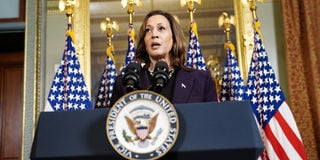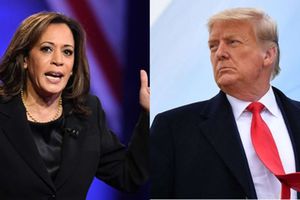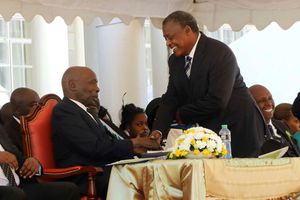
US Vice President Kamala Harris delivers remarks at a press conference following a meeting with Israeli Prime Minister Benjamin Netanyahu in Washington, DC, US, on July 25, 2024.
in Los Angeles, California
There are two active big conflict systems in the world today and a third could slowly be coming to the boil. In the Middle East, Israel has been pummeling the Palestinians after the surprise attack on the Israeli homeland by Hamas fighters on October 7 last year. Iran has joined that fight through proxies, Hezbollah in Lebanon, Houthi in Yemen and militia groups from Iraq and Syria. The potential for escalation and plunging the whole Middle East into war and possibly dragging in other countries further afield looms.
In Eastern Europe, Ukraine has been fighting for survival against nuclear-armed Russia, which invaded it on February 24, 2022, expecting the war to last only a few days.
Ukraine, heavily supported by Nato countries and the US, has put up a surprisingly stiff defence, but there is always fear that President Vladimir Putin, supported by China, North Korea and Iran, will attack one of the Nato countries being used to resupply Ukraine and set off World War III. As it is, these countries are already facing off through proxy in the largest conflict in Europe since World War II.
In Asia, the rise of China to challenge the US as the world’s economic and military power and China’s territorial aggression and bullying of Pacific nations all the way from Japan to the Philippines is generating tensions. The flashpoint is likely to be Taiwan, which broke away from mainland China in 1949 and has continued to exist as a separate nation, which China claims as its territory and does not recognise. Taiwan is protected by the US and President Biden has made it quite clear that the US will fight to protect Taiwan from a Chinese invasion and forced re-union.
On top of the possibility of war, the world is destabilised by other social and economic currents. The rise of far-right groups in Europe, the rise in migration and the resultant anti-immigrant sentiment sweeping through most of Europe and to some extent the US, threatens to upend hitherto moderate societies. The increasing pressure on the existing world order by Brics and competition between China and the West, which has sucked Africa into turbulent superpower politics, is another dynamic, along with volatility in world markets and economies.
President matters
Because of the centrality of America in world affairs, the person who becomes the president matters a lot in how the world, and its future, is shaped. With his experience, stature and networks as a property tycoon, not to mention his assertive personality and celebrity appeal, the Republican candidate, Donald Trump, would have been the one person who would reinforce US power and steady the globe.
But during his first term as President, Trump had significant problems finessing the traditional levers of US power – the so-called Deep State – and he sometimes appeared to side with traditional American adversaries against his own security bureaucracy. And given his antipathy towards US allies, especially Nato which he has rowed with over financing and threatened to pull out of, and gravitation towards Russia, China and North Korea, Trump in all likelihood could add confusion to America’s geopolitical dynamic.
Vice President Kamala Harris entered public service as District Attorney in her native San Francisco, California, for seven years before going on to be elected Attorney General of her state for six years and serving one four-year term in the US Senate.
She ran for President against Biden in 2021 and ultimately ended up as his running mate and eventual Vice-President. At 60, she is much younger than Trump, 78, at a time when voters are rather jittery about the infirmity of older leaders, which saw President Biden being prevailed upon to step down for her. Can she beat Trump who enjoys near-fanatical support from the more right-wing sections of the Republican base?
US presidential elections are not determined by the popular vote but by an electoral college. Each of the 50 states is assigned a certain number of electoral college votes, depending on population, from the largest, California with 54 and New York 28, to the smallest, Wyoming, South Dakota, North Dakota and Vermont with 3 each. A candidate who wins the popular vote in a state gets the electoral college votes and the one who wins the majority of votes in the electoral college becomes president. However, most states are already spoken for, they will always either vote Republican or Democrat. The contest is determined by a small group of states, which can swing either way depending on any number of factors. In the 2024 election, it is down to seven so-called swing states: Nevada, Wisconsin, Georgia, Pennsylvania, Arizona, Michigan and North Carolina, with a combined 90 electoral college votes.
Because voters in these states are almost evenly split between the two parties, elections come down to groups of voters with defined interests or attitudes, such as independents, women and other minorities. In 2022, 43 per cent of Americans registered Independent, 27 per cent Republicans and 27 per cent Democrat. Perhaps unsurprisingly, independents have decided the outcome of general elections for the last 40 years.
Latest polls show Harris leading Trump by three per cent and show a big swing among independents. The Miami Herald reports: “The latest NPR/PBS News/Marist poll shows 53 per cent of independent respondents support Harris, while 44 per cent support Trump. The nine-point lead represents a big swing from the previous month, when the former President led by 14 points among independents.”
White male voters
Trump’s greatest strength remains white male voters without a college degree from the key swing states. But he has problems with minorities and women. He lost a rape case and was fined $5 million for defaming the victim, journalist E. Jean Carrol. Additional damages of $83.3 million dollars were added in the same court.
Trump delivered on a promise to reverse a law that protected women’s abortion rights, which was overturned by the Supreme Court in 2022, driven mainly by conservative judges appointed by Trump who has claimed credit for the decision. This has triggered several years of behind-the-scenes backlash on propositions supported by Trump and his surrogates, including in the states considered to be deep Red Conservative Republicans like Kansas, Montana, and Ohio. Harris leads Trump among women by 13 percentage points in the latest polls.
Harris could do well among minorities, which constituted a good part of the coalitions that elected Barrack Obama in 2008 and President Biden in 2020. Obama won 95 per cent of all black votes, a group that reliably votes Democratic. Polls show that Harris leads Trump among Black voters by 54 per cent.
Asian Americans, 62 per cent of whom voted for Obama, are another block that might go her way. Being of Indian heritage, she could even poll better than Obama. Hispanics, the second biggest vote in the US, which overwhelmingly went to Obama, are more likely to look at her favourably than Trump, who has described immigrants as “animals”.
There are other signs that Harris is growing in strength. She is breaking records in campaign donations since her entry in the race. While pundits predicted that the donation ‘euphoria’ would fade away, it seems to accelerate. For instance, within six hours of Harris picking Minnesota Governor Tim Walz as her running mate, the campaign got more than $20 million in small donations. And in the first 10 days of her entry, Harris attracted more than 170,000 volunteers to her campaign. The volunteers will be deployed to battleground states to knock on doors and help turn out the vote.
Going by the enthusiasm and momentum of her campaign, Harris may follow the Obama’s path, which opened up new battleground states like Indiana, and North Carolina. While Florida may look out of reach for her, the delegate-rich Texas seems close enough and with the right demographics to become a battleground state. What seemed impossible may yet turn out to be quite possible: A woman in the White House.










